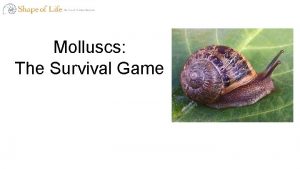Effects of Caffeine on Lewis Moon Snail Student

- Slides: 1

Effects of Caffeine on Lewis Moon Snail Student Name Science and Math Institute Results Introduction The Lewis moon snail is an active foraging predator on the ocean floor and often mudflats. One of the unique traits of the moon snail is that it absorbs water to grow its size to fit it’s shell. During this process the snail can absorb harmful toxins in the water, one of which, is potentially caffeine. In a previous study on the affects of caffeine on terrestrial gastropods in 2015 clearly states the negative affects of caffeine on gastropods. The study conducted treated snails with 2% solutions caused visible irritation to all individuals. 95% of tested snails treated died, and was deemed a powerful chemical for protecting food crops. Caffeine has also been shown to impair plant cell division and inhibit vitro germination; important steps of plant growth. (Hollingsworth, R. G. , Armstrong, J. W. , & Campbell, E). Based on the knowledge that caffeine can be used as a natural snail repellant, the effects of it in the marine ecosystem can be potentially harmful. Humans also drink a surplus of coffee daily, leading to caffeine in our waste and residue in our cups and trash. In this study, students set out to study the effects of caffeine on the marine ecosystem of the Puget Sound. This study was specifically studying the marine gastropod: Lewis Moon Snail. Objectives • Determine the effects of caffeine on the species of Lewis Moon Snail • To observe and measure the amounts of caffeine in the sound. • Compare amounts of caffeine before and after water treatment. Figure 1 The graph shows the results of the mass spectrometer marking the caffeine component found to peak at 3. 05 minutes. The peak reads 5. 84 e 4 ppb and the total area was 4. 51 e 4. The graph is measuring the percentage of caffeine present versus the time the mass spectrometer processes the sample. Materials and Methods Two samples were collected from the end of the swale at the Tacoma water treatment plant. The samples were then taken and tested under a hood. The vent is on to remove chemicals that might become volatile and cause harm. The water samples were then processed through an extraction manifold using the Oasis HLB removes the caffeine from water, and then the sample was finally eluted with 5/95 methanol/water wash before going into the dry down. The dry down method used nitrogen to remove liquid from the samples so they can reconstitute in a known quantity of liquid and finally transferred to small test tubes. The M/Z ratio was then calculated and developed in chart using a Mass Spectrometer (GS_XS UPLC QTOF) as shown on right. RESEARCH POSTER PRESENTATION DESIGN © 2015 www. Poster. Presentations. com Conclusion In conclusion the data was significant. The amounts of positive ions for caffeine in the water sample from the last point of the treatment plant was 58, 400 ions tested. While this lab does not conclude if caffeine has a leading negative affect on the health of marine organisms, based on background information it can be said that caffeine contamination is not benefitting the ecosystem in any ways. Based on the declining populations of marine organisms in general and the increase of chemical waste in our sound, there is evidence of correlation between the two. The effects on the Lewis moon snail are still only backed up by these of caffeine in natural slug and snail poison. The water treatment plant in Tacoma Washington is one of the few facilities battling the ongoing water pollution problem. By testing water from the beginning of the treatment process to a sample from the last stop before water reaches the sound, we could compare the levels of caffeine potentially being filtered out of the water. The comparison from the first to last stop shows a difference of 5, 000 caffeine ions (63, 400 to 58, 400). While being measured in parts per billion this number is not very significant, but does show an adequate change in water quality. Lastly it is important to understand that caffeine is one of trillions of pollutants being found in our water system. As humans we can reduce the amount of harmful affects emitted into our local marine ecosystems by changing basic daily routines. Steps like using environmental friendly lawn products, or paying attention to the ingredients in sunscreen before wearing it in the ocean or picking up your digs waste to avoid runoff pollution are all easy steps to make a change for the health of the Lewis moon snail and other marine organisms. References Hollingsworth, R. G. , Armstrong, J. W. , & Campbell, E. 92005, March 16). Caffeine as a novel toxicant for slugs and snails. Retrieved May 23, 2018, from https: //onlinelibrary. wiley. com/doi/abs/10. 1111/j. 17447348. 2003. tb 00233. x Acknowledgements Image 1 Photo of Lewis Moon Snail Image 2 Point Defiance Regional Storm-water Treatment Facility Matthew Lonsdale; Administrator University of Puget Sound; Chemistry Department Tacoma Public Schools; Science and Math Institute

